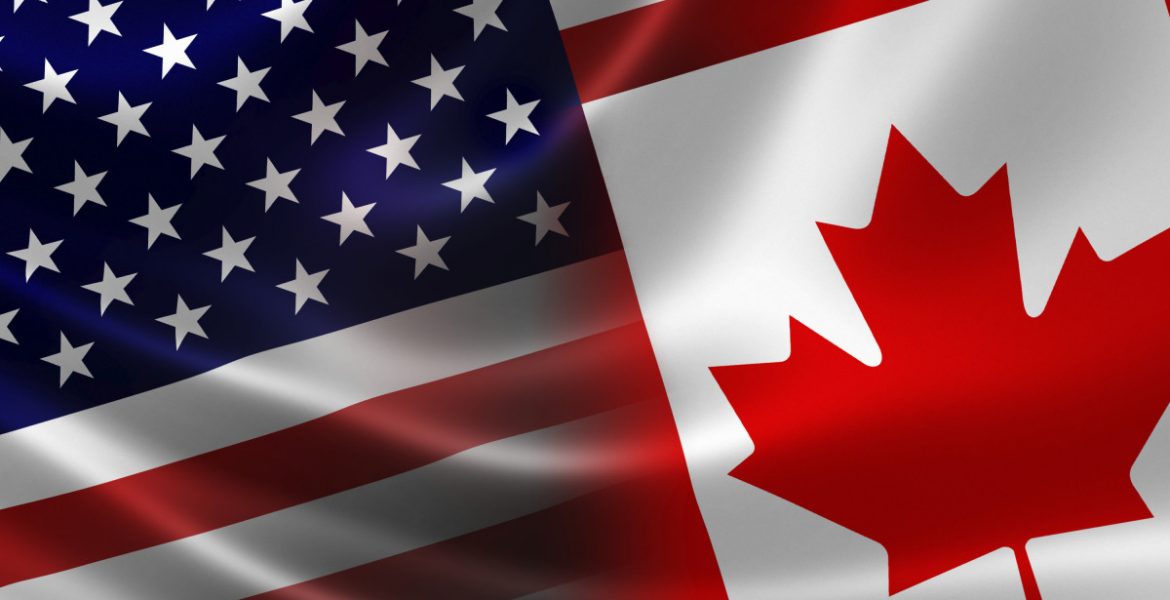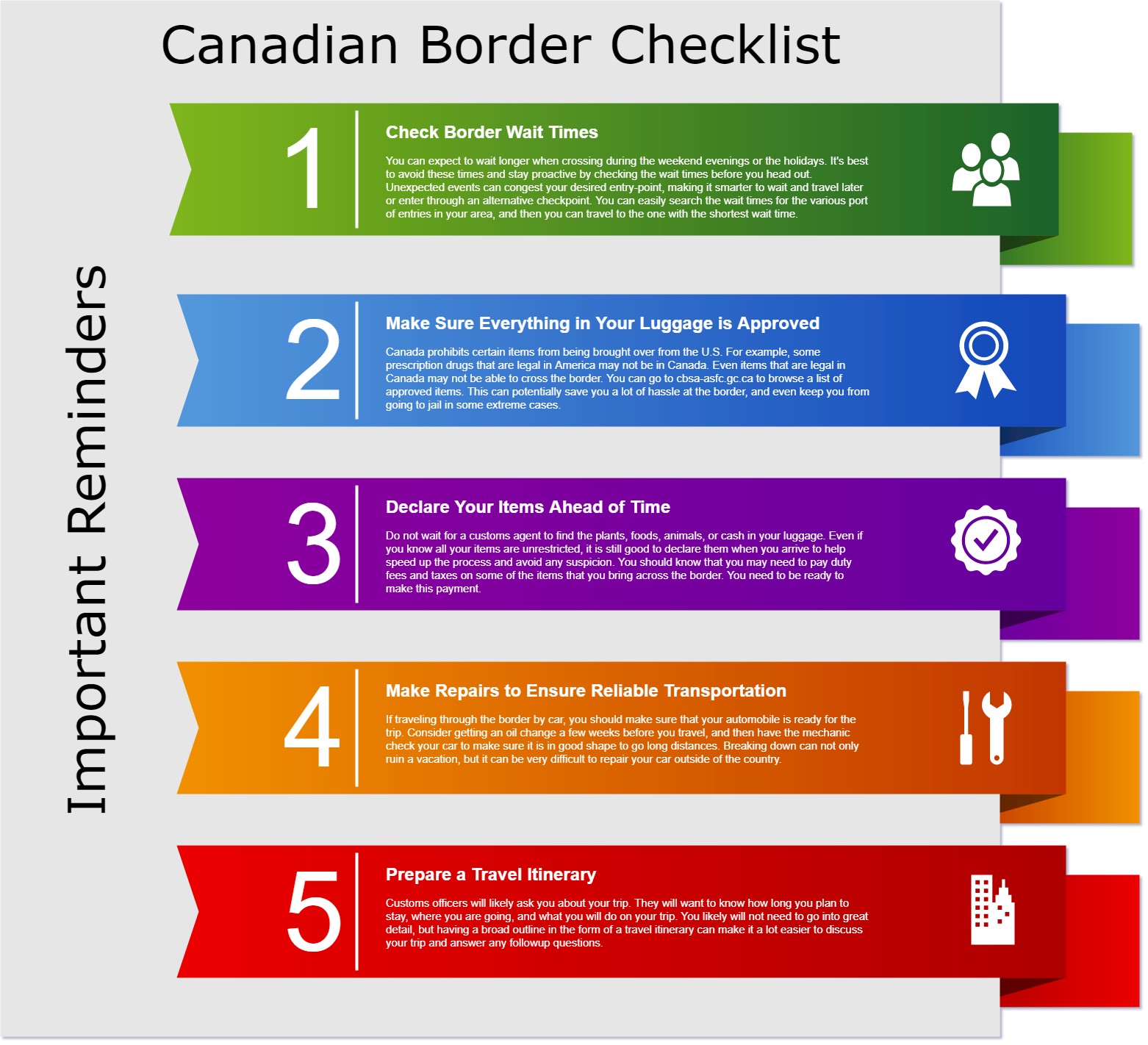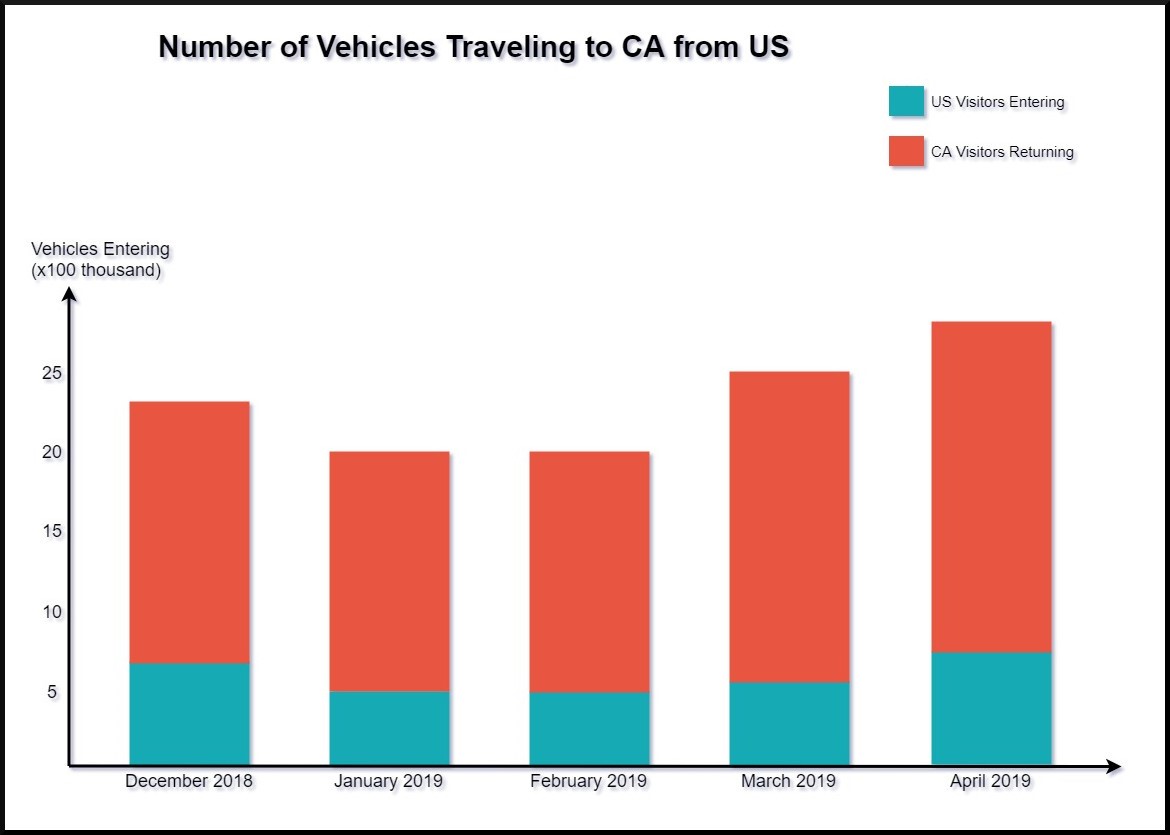
Ultimate Guide: US - Canada Border Crossing for US Citizens
Avoid common mistakes and learn what to know before traveling across the Canadian border from the U.S.
There are nearly a hundred ways to get in trouble at the Canadian border. The Canada Border Services Agency (CBSA) enforces over 90 regulations, meaning that travelers who are not careful may accidentally find themselves on the wrong side of the law.
That said, millions travel from the U.S. into Canada without incident each month. Follow our guide and you should be able to make it through.
The US / Canada Border
The border between the United States and Canada is the longest land border between any two nations in the world.
There are over one hundred different places to cross the US Canada border legally by land, as well as many airports through which individuals fly daily. It is by following careful and well-respected rules that the border-crossers see success.
Requirements and Guidelines
US Canada border crossing involves following certain requirements and guidelines. While most of these have to do with the types of documentation that a traveler will need to provide, it is also wise for travelers to keep in mind that specific rules may need to be followed as well.
Though the US Canada border is a peaceful boundary, it is still very important to take it seriously. Failure to comply with any directions can lead to jail time and can even prevent travelers from visiting Canada in the future. Those who are non-compliant face stricter scrutiny and can find themselves held for long periods before being released. It is also vital that anyone asked a question at the border be prepared to answer honestly.
There are several questions that might be asked of an individual crossing the border, such as questions about:
- The purpose of the visit
- The length of stay
- The precise area being visited
- Any items or animals in the traveler’s baggage or vehicle
American citizens can stay in Canada for up to six months without having to apply for a visa, but they are only allowed to do so if they are visiting. One of the primary goals of the questions asked at the border is to ascertain whether a traveler is simply visiting Canada as a tourist or whether he or she is attempting to immigrate without following the proper procedures.
It is also important to note how having a criminal record can affect one’s experience at the border. While Canada is lenient to those who have committed misdemeanors, committing many felonies will bar foreigners from entering the country. This can include felony DUI. Neither the US, nor Canada, allows those with felonies to enter their respective countries. Canada considers most (if not all) DUI's as felonies regardless of how we're treated in US courts. If your DUI arrest was dismissed with no charges, it is up to you to bring proof of this dismissal.
Bringing Food, Plant, and Animal-Related Products into Canada
For in-depth information on the specific requirements for bringing food, plant, and animal-related products into Canada, we recommend using the Automated Import Reference System (AIRS).
It’s important to note that while one may be technically allowed to bring an item over the border, the corresponding duty fees may make it impractical. For instance, you can bring up to 44 pounds of cheese across the Canadian border, but the fees for doing so can be very expensive. When the value of the dairy products exceeds 20 Canadian dollars, the duties can go up to 300 percent.
Animal fat
- up to 44 pounds per person
Baked goods, candies, etc.
- up to 44 pounds per person
Dairy products like milk, cheese, yogurt, and butter
- up to 44 pounds per person
Fish and seafood
- pufferfish and Chinese mitten crab are NOT allowed
- you will not be required to show an import permit if bringing fewer than 10 dead finfish, 4 crustaceans, or 3 kilograms of mollusks
Dried fruits, vegetables, and herbs
- fewer than 15 packages per person (not to exceed 550 pounds)
Frozen or canned fruits, vegetables, and herbs
- no more than 15 cans or frozen packages of fruit per person (not to exceed 550 pounds)
- no more than 44 pounds of frozen vegetables per person
Fresh Fruits and vegetables (no plant debris, soil, or leaves)
- no more than eight pounds of U.S. number one potatoes (commercially packaged) per person
- no more than 550 pounds of fresh fruits and vegetables in a maximum of 15 packages per person
Carcasses of game animals
- allowed when the traveler can present a hunter's permit and license, except when provincial restrictions apply
Spices, tea, coffee, condiments
- no limit
Infant formula (milk or non-milk based; dry or liquid formula)
- must be commercially packaged and sealed, for personal use only, and no more than 44 pounds per person
Leather skins and hides
- you may only bring fully tanned skins and hides
Meats: jerky, deli meats, patties, etc.
- no more than 44 pounds per person for certain types of meat (no more than one turkey per person)
- containers must identify the product
- you may be required to prove the product’s country of origin
Seashells
- you may bring seashells and some art created using seashells, as long as the shells are free of any animal matter, soil, or plants
Wooden souvenirs
- wooden souvenirs are allowed as long as the wood is free of any bark or insects (if the wood looks like it was once infested or inhabited by insects, you may be prohibited from crossing the border with the item)
Document Requirements
Most travelers will only need to prove their American citizenship in order to cross the US Canada border. While it used to be the case that an American could travel across the border with nothing more than a driver's license, today's higher-security border crossing does tend to require one of several pieces of specific identification. Fortunately, few of these documents are hard to acquire. The relevant documents include:
- A valid US passport or passport card
- A NEXUS Card
- An Enhanced Driver's License (by land only)
The most efficient document to use when crossing the border is a valid American passport. Frequent travelers may choose to apply for a NEXUS card, which is a pre-screened entry document that allows for quicker entry. Residents of some border states may also have the option to apply for an Enhanced Driver's License, which allows for entry through land and sea crossings.
It is still possible to enter Canada without a valid passport. Though it's not preferred, a combination of a valid government-issued ID and a document proving the traveler's American citizenship will be accepted. Documents accepted include an American birth certificate, naturalization paperwork, or another document that proves the traveler's residency status. Children under sixteen also have the option to use these documents without government identification to cross the border.
Note that entry becomes more difficult when the custodial parent of the child is not with the party. In this situation, a responsible adult will be required to bring along a note from the custodial parent giving him or her permission to travel with the child. This letter must include the parent's name and contact information. Canadian authorities take human trafficking seriously, so those who travel with children can expect enhanced scrutiny at the border.
Reservation for Service
There are some steps that must be taken to make reservations for any type of travel service that will take travelers across the US Canada border. Though the requirements are somewhat less stringent than what one might find when traveling to other countries, it is nonetheless a good idea to start by figuring out exactly what type of information the travel company requires in order to speed up crossing the international border.
Even if the traveler does not plan to stop in Canada, bringing along the requisite travel documents and identification papers is still a good idea. Travelers on a train, for example, may still need to show their documentation even if their destination is not on Canadian soil. It is generally better to be over-prepared than to be under-prepared, so it is always wise for travelers to make sure that they have as much documentation as possible when crossing any type of international border.
It is always a good idea to speak directly to a specialist when making reservations that would take a traveler across the border. This can be helpful for all involved, as it ensures that the travel provider is able to give its customers the requisite information for crossing the border and helps to prevent embarrassing situations from occurring when the necessary information is overlooked.
It is ultimately the responsibility of the traveler and not the transportation company to ensure that all of the proper documentation is in order.
Seasoned travelers know to print out a checklist for what to bring to the Canadian border. Then, on the day of departure, they go through the list to make sure they have everything ready.
What to Expect When Crossing the Canadian Border by Car
Thousands of people travel into Canada every day. Many do so while riding in an automobile. If the traveler has the correct paperwork and is willing to answer a few questions, he or she should able to enter Canada without incident.
Most entering Canada by car are Canadians on their way back home, as shown in the chart below.
It is very important that travelers only cross into Canada at designated crossing points. While there are certainly many miles of lightly patrolled border between the two countries, using unofficial entryways is illegal. Most border crossings are very easy to identify both by the border-crossing stations and by the long lines of vehicles attempting to gain entry to the other country.
Travelers will start the process of crossing the US Canada border by getting in line to speak with a border agent. Following these rules and recommendations should help speed the process along:
- Make sure to have all documentation ready
- Turn off the car radio and remove any sunglasses
- Be prepared for the border agent to ask about the duration of the stay and the reason for visiting.
It's also important to remember that the border agent will be on the lookout for anything unusual. Travelers may be asked for their vehicles' registration paperwork, to roll down their windows, or to let the officer look in the vehicle's trunk. Failure to comply will, at best, stop an individual from being able to enter the country. Likewise, travelers must declare any items that they are bringing into the country and provide rabies vaccination paperwork for any pets that are crossing the US Canada border.
What to Expect When Crossing the Canadian Border by Air
The process of traveling to Canada by air is different from traveling by car. Millions of people fly into Canada every day. The country has managed to streamline the process in such a way that tends to be a bit quicker than going through the land-based crossings.
These are the steps to crossing into Canada by plane:
- When traveling to Canada, passengers will be required to fill out a Declarations Card. This card will contain answers to the questions that a land-based border agent would typically ask, including who is in the traveler's party as well as the time and duration of their stay in Canada. Up to four people who live together can use one card, and travelers will need to keep this card on their person once they land.
- The next step will be at the Primary Inspection Checkpoint. Here, a border agent will inspect the Declarations Card as well as all the other required paperwork (this can vary by situation, as described above). Travelers will also be asked to declare any items or animals that they have brought with them.
- Once they pass the primary checkpoint, travelers will be directed to a baggage claim. After collecting their baggage, they will go to the Secondary Inspection Checkpoint. At this point, it's normal for the border agents to check the traveler's documentation a second time, to go through some of the same questions, and to even search through the traveler's luggage before sending them through.
Note that anyone who is a member of the frequent traveler program will only have to go through the second checkpoint. Most of the process will be automated for those who hold this status. It's also good to note that those with connecting flights will typically have to have their baggage inspected and re-checked before continuing, even if their final destination is not in Canada.
US - Canada Border Wait Times
The wait times at the border tend to vary greatly by time, date, and location. Typically speaking, it's faster to cross a border by air than it is to do so by car, and those who travel with more luggage or with larger parties tend to have longer waits than their peers. Border wait times are helpfully posted by both American and Canadian agencies on a regular basis, though most of these wait times tend to be slightly inaccurate. As such, it's generally a better idea to think of the worst-case scenarios than to look for a specific posted time, especially when one has a time-sensitive appointment on the other side of the border.
The stated minimum amount of time for a traveler to get through customs at the airport is about fifteen minutes. This tends to be on the lower end of the spectrum. Most travelers experience a wait of at least a half an hour. This can be significantly longer during the holidays or if a large party is traveling at once, with some travelers reporting wait times of up to ninety minutes during the busiest parts of the year.
Border wait times are much harder to calculate by car. The following issues will generally extend the wait of most drivers:
- Time of day
- Time of year
- American and Canadian holidays
- Weather
- Location of the crossing
- General traffic
It is entirely possible for an individual who tries to cross during the holidays or at a busy point of entry (Niagara Falls, for example) to wait up to two hours on the bridge. On the other hand, someone who crosses at a smaller crossing early in the morning may get through in just a few minutes.
It is generally recommended that travelers give themselves at least forty-five minutes to get through the border no matter what their crossing method. Outside of the busiest times of the year at the busiest crossings, this should give most an ample amount of leeway for their travel plans.
A typical US Canada border crossing is relatively simple if the travelers have the right documentation, follow the rules, and comply with any requests given to them by the border agents. Though the process can be somewhat slow and may feel invasive to some, it is still one of the simplest border crossings in the world. It is always a good idea to keep track of any changes to travel requirements. Previous changes to travel rules have given significant grace periods, but it's always better not to be caught unaware.

